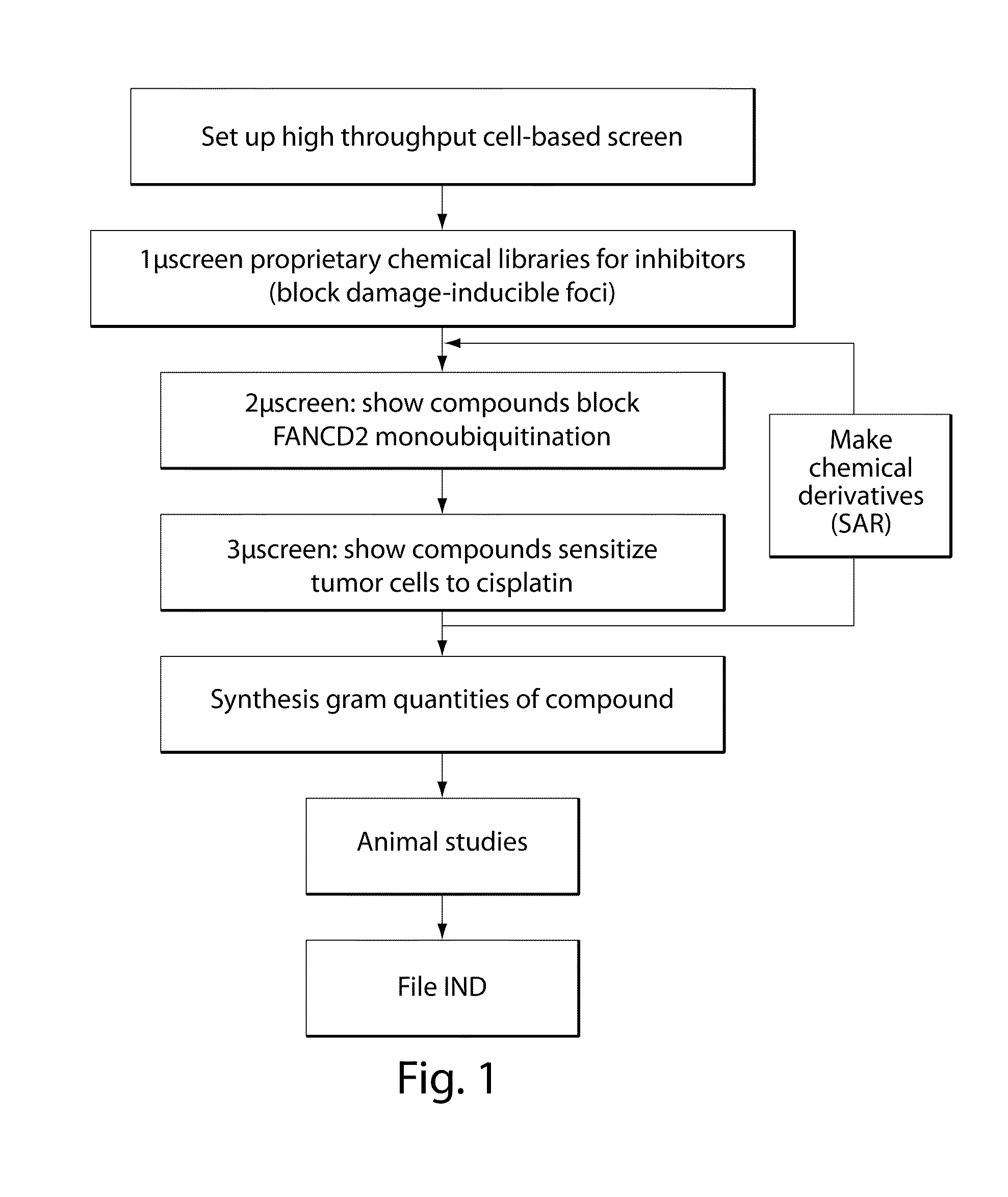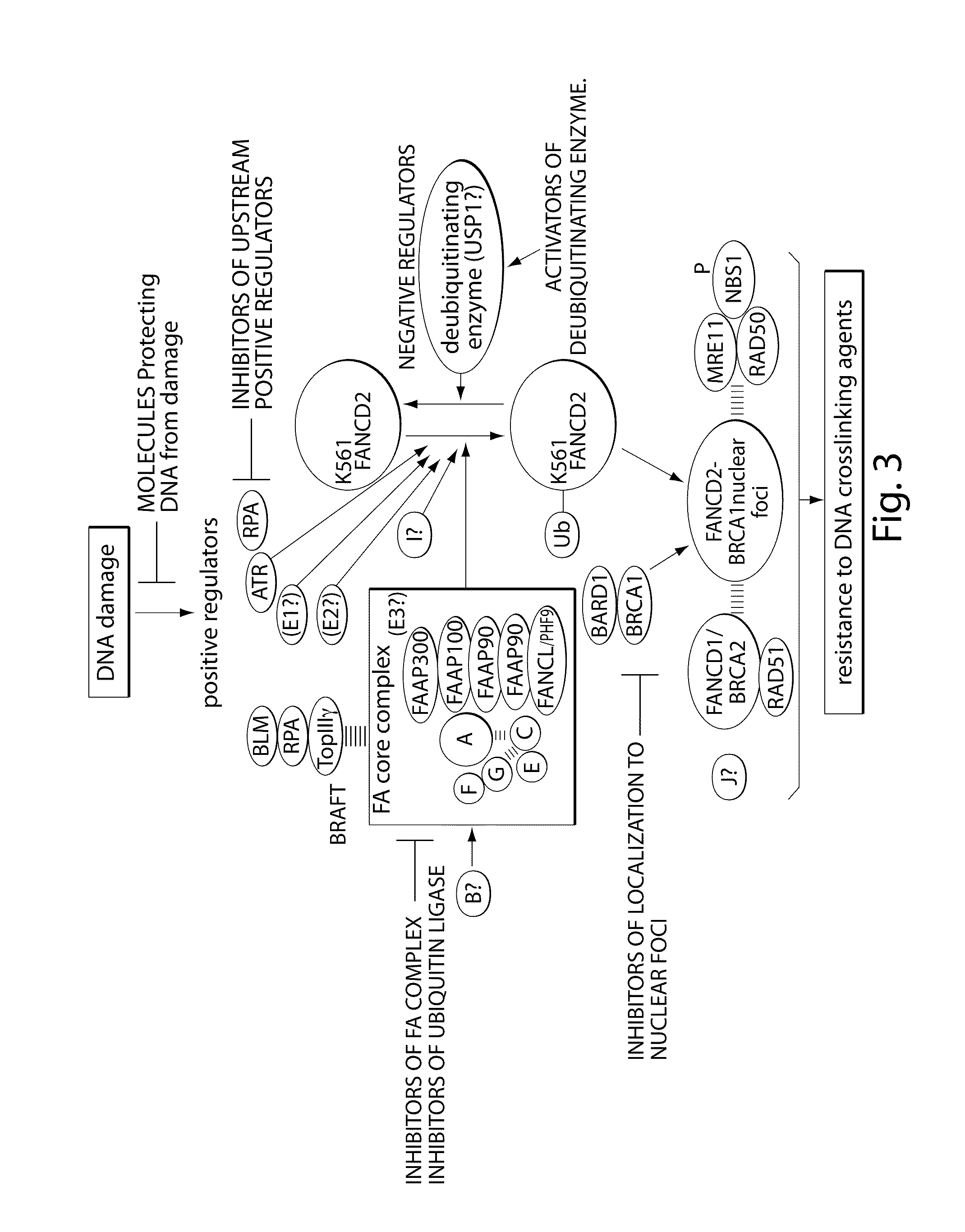Compositions and methods for the treatment of cancer
a cancer and composition technology, applied in the field of compositions and methods for the treatment of cancer, can solve the problems of ineffective chemosensitizers, undesirable side effects of chemosensitizers, and inability to precisely explain the intrinsic and extrinsic resistance of chemosensitizers, so as to increase the sensitivity of a neoplastic disorder
- Summary
- Abstract
- Description
- Claims
- Application Information
AI Technical Summary
Benefits of technology
Problems solved by technology
Method used
Image
Examples
example 1
Methods
[0181]HeLa cells, PD20 (FA-D2) fibroblasts, and GM6914 (FA-A) fibroblasts were grown as previously described (Taniguchi et al. (2002) Cell. 109:459-472). Briefly, cells were grown in Dulbecco's modified eagles medium (DMEM) supplemented with 15% fetal calf serum (FCS). The FANCF-deficient ovarian tumor line (2008) and FANCF cDNA corrected 2008 cells were previously described. Breast cancer cell line MCF7 was purchased from the American Type Culture Collection (Manassas, Va.). OVCAR5 and OVCAR8 were grown as previously described.
Plasmids and Retroviral Infection
[0182]The retroviral expression vector, pMMP-puro (Ory et al., (1996) Proc Natl Acad. Sci USA. 93:11400-11406) and pMMP-puro-FANCD2 was described previously (Timmers et al., (2001) Mol Cell. 7:241-248; Garcia-Higuera et al., (2001) Mol Cell. 7:249-262). pMMPpuro EGFP-FANCD2 was constructed by adding EGFP cDNA sequence (from pEGFP-N1 (Clontech)) to the N-terminus of the FANCD2 cDNA sequence. T...
example 2
Identification and Characterization of Potential Inhibitors of FANC D2 Ubiquitination and Foci Formation
[0189]Using the microscopy methods detailed above, the 489 known bioactive compounds within the collection of the Institute of Chemistry and Cell Biology (ICCB), Harvard Medical, were screened for inhibition of IR-mediated FANC D2 foci formation. A number of positives were identified using the primary screen, which employed high throughput fluorescence microscopy to identify agents which blocked the formation of FANC D2-containing foci upon exposure to ionizing radiation. A number of compounds were identified, as described within Table 2.
[0190]
TABLE 2Compounds identified through screen of ICCB BioactivesCompoundKnown functionAlsterpaullonecdk1 / cycB inhibitor(+−)13-HODEbioactive lipidNIFEDIPINEcalcium channelsPENITREM Apotassium channelsGeladanamycinHSP90 inhibitorGo6976PKC inhibitorLEUKOTRIENE B3bioactive lipidTrichostatin-Ahistone deacetylase inhibitorAG-370PDGF receptor kinase i...
example 3
Identification and Characterization of H-9 as an Inhibitor of FANC D2 Ubiquitination and Foci Formation
[0192]H-9 was identified as an inhibitor of the FA pathway using the high-throughput screen as described above. As shown by fluorescence microscopy in FIG. 7, H-9 inhibited the formation of FANC D2 foci in the 50-100 μM range. As a secondary screen using immunoblot analysis to determine the relative pools of monoubiquitinated FANC D2, H-9 treatment was found to decrease the overall level of FANC D2 monoubiquitination (FIG. 8). H-9 did not affect ATM-dependent phosphorylation of FANC D2 but did inhibit ATR dependent phosphorylation of CHK1. Finally, the hypersensitivity of the FANC F deficient 2008 cells, which is restored to wild-type levels when transfected with the FANCF cDNA, can be mimicked in 2008+FANCF cells by contacting the cells with curcumin (FIG. 9). Taken together, these results suggest that H-9 blocks the FA / BRCA pathway by inhibiting ATR kinase, either directly or ind...
PUM
| Property | Measurement | Unit |
|---|---|---|
| body weight | aaaaa | aaaaa |
| weight | aaaaa | aaaaa |
| time | aaaaa | aaaaa |
Abstract
Description
Claims
Application Information
 Login to View More
Login to View More - R&D
- Intellectual Property
- Life Sciences
- Materials
- Tech Scout
- Unparalleled Data Quality
- Higher Quality Content
- 60% Fewer Hallucinations
Browse by: Latest US Patents, China's latest patents, Technical Efficacy Thesaurus, Application Domain, Technology Topic, Popular Technical Reports.
© 2025 PatSnap. All rights reserved.Legal|Privacy policy|Modern Slavery Act Transparency Statement|Sitemap|About US| Contact US: help@patsnap.com



